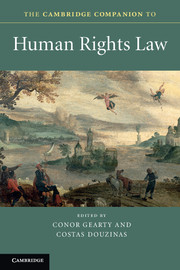Book contents
- Frontmatter
- Contents
- Preface
- Notes on contributors
- Acronyms and abbreviations
- Introduction
- Part I All kinds of everyone
- Part II Interconnections
- 4 Foundations beyond law
- 5 The interdisciplinarity of human rights
- 6 Atrocity, law, humanity: punishing human rights violators
- 7 Violence in the name of human rights
- 8 Reinventing human rights in an era of hyper-globalisation: a few wayside remarks
- Part III Platforms
- Part IV Pressures
- Index
- References
6 - Atrocity, law, humanity: punishing human rights violators
from Part II - Interconnections
Published online by Cambridge University Press: 05 December 2012
- Frontmatter
- Contents
- Preface
- Notes on contributors
- Acronyms and abbreviations
- Introduction
- Part I All kinds of everyone
- Part II Interconnections
- 4 Foundations beyond law
- 5 The interdisciplinarity of human rights
- 6 Atrocity, law, humanity: punishing human rights violators
- 7 Violence in the name of human rights
- 8 Reinventing human rights in an era of hyper-globalisation: a few wayside remarks
- Part III Platforms
- Part IV Pressures
- Index
- References
Summary
François de Menthon, one of the French Prosecutors at the Nuremberg war crimes trial in 1945, was assigned the task of defining humanity. The context was a trial in which a more or less new legal category – crimes against humanity – had to be created to encompass the system of abuse and murder instituted by the Nazis in the mid 1930s. This development had a spatial imperative (Nazi crimes committed against Germans in Germany fell outside the category of ‘war crimes’, a category encompassing only acts committed against foreign soldiers or civilians), a temporal imperative (war crimes applied only to acts committed during war and excluded peace-time offences) and a moral imperative (it was believed that an unprecedented level of baseness had been reached and that the response to it required a new language and new law).
In its delineation of crimes against humanity, de Menthon’s opening address to the International Military Tribunal invoked three distinguishable concepts. The first was the idea that certain acts were crimes against human beings regardless of the race, religion, national affiliation or ethnicity of the victims. This was international criminal law in its universalising mode, and it was an inspiration for two 1948 landmarks: The Genocide Convention (in the field of criminal law) and The Universal Declaration of Human Rights (UDHR) (in the field of human rights law).
- Type
- Chapter
- Information
- The Cambridge Companion to Human Rights Law , pp. 114 - 133Publisher: Cambridge University PressPrint publication year: 2012
References
- 1
- Cited by

